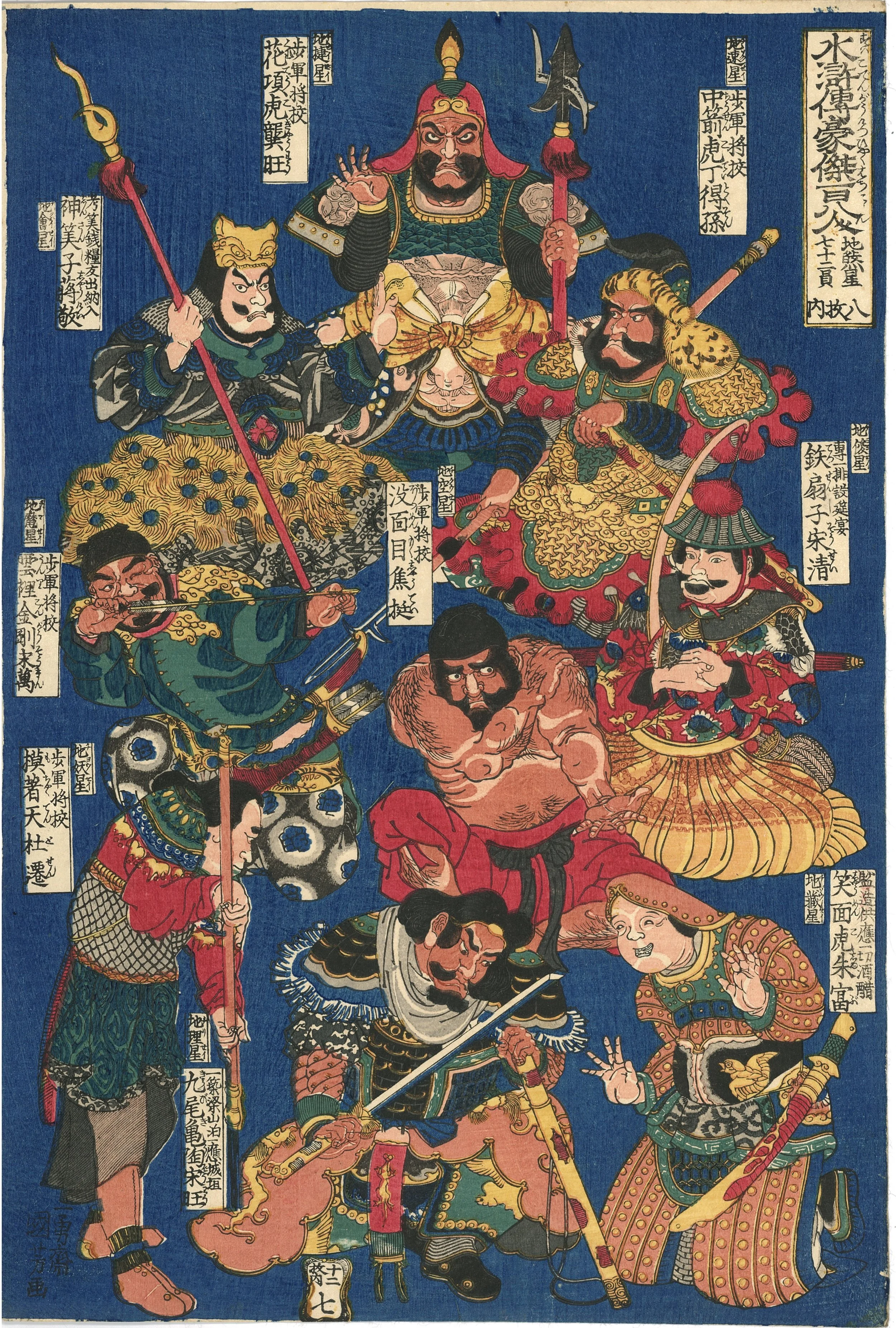Kuniyoshi | From the 7 Sheets of the 72 Earthly Stars, Sheet 8 of 12, One Hundred and Eight Heroes of the Shuihuzhuan
歌川国芳 Utagawa Kuniyoshi (1798–1861)
水浒伝豪杰百八人 地煞星七十二员八番内 十二枚之内七
From the 8 Sheets of the 72 Earthly Stars, Sheet 7 of 12, from the series One Hundred and Eight Heroes of the Suikoden(Shuihuzhuan in Chinese)
1830-31
木版画 | 纵绘大判 | 38cm x 25.5cm
Woodblock-print | Oban tata-e | 38cm x 25.5cm
第一版本由出版商加賀屋吉右衛門于1803-1831年出版,第二版本由出版商伊場屋仙三郎于1845年再版,此画为第一版本;早期版次;颜色鲜艳;品相非常好
This is the first edition published by Kagaya Kichiemon in 1830-31, the second edition republished by Ibaya Sensaburo in 1845; fine impression, color and condition
$1,800
Interested in purchasing?
Please contact us.
歌川国芳 Utagawa Kuniyoshi (1798–1861)
水浒伝豪杰百八人 地煞星七十二员八番内 十二枚之内七
From the 8 Sheets of the 72 Earthly Stars, Sheet 7 of 12, from the series One Hundred and Eight Heroes of the Suikoden(Shuihuzhuan in Chinese)
1830-31
木版画 | 纵绘大判 | 38cm x 25.5cm
Woodblock-print | Oban tata-e | 38cm x 25.5cm
第一版本由出版商加賀屋吉右衛門于1803-1831年出版,第二版本由出版商伊場屋仙三郎于1845年再版,此画为第一版本;早期版次;颜色鲜艳;品相非常好
This is the first edition published by Kagaya Kichiemon in 1830-31, the second edition republished by Ibaya Sensaburo in 1845; fine impression, color and condition
$1,800
Interested in purchasing?
Please contact us.
歌川国芳 Utagawa Kuniyoshi (1798–1861)
水浒伝豪杰百八人 地煞星七十二员八番内 十二枚之内七
From the 8 Sheets of the 72 Earthly Stars, Sheet 7 of 12, from the series One Hundred and Eight Heroes of the Suikoden(Shuihuzhuan in Chinese)
1830-31
木版画 | 纵绘大判 | 38cm x 25.5cm
Woodblock-print | Oban tata-e | 38cm x 25.5cm
第一版本由出版商加賀屋吉右衛門于1803-1831年出版,第二版本由出版商伊場屋仙三郎于1845年再版,此画为第一版本;早期版次;颜色鲜艳;品相非常好
This is the first edition published by Kagaya Kichiemon in 1830-31, the second edition republished by Ibaya Sensaburo in 1845; fine impression, color and condition
$1,800
Interested in purchasing?
Please contact us.
Utagawa Kuniyoshi (1798–1861)
Warriors, ghosts, crabs and cats.
The woodblock print designs of Utagawa Kuniyoshi, one of Ukiyo-e’s most vibrant and creative 19th Century masters, encompass more than that – he depicted landscapes and beautiful women, too – but those are the first genres that come to mind when contemplating this wonderful and eccentric genius and his sprawling, timeless body of work.
From an early age, the young Kuniyoshi was fascinated by drama and history – with a big helping of the supernatural. He loved nature and animals, too – especially cats: again and again they pop up in designs throughout his career (adding a premium to the prices those woodblock prints fetch today). Starting out as a relatively traditional student of the Utagawa school, he soon developed his hugely energetic style, full of dynamic action, and eventually passed it on to his many students – Yoshitoshi being the most famous. Along with Kunisada and Hiroshige, he was among the most prolific of all Ukiyo-e artists.
He was born Yoshisaburō on January 1, 1798 to a silk dyer. Some say his father’s rich patterns influenced his bold, colorful designs. He always loved legends and history. By age 12 he had shown a talent for drawing and become a student of the great Toyokuni, who gave him the name Kuniyoshi. He also studied the Tosa, Kano and Maruyama painting styles.
It took awhile for him to find his place in the thriving Ukiyo-e world. Then in the 1820s he produced his first epic warrior triptychs, and his career success was assured. He often gave legendary heroes fanciful and intricate tattoos of his own design, starting a style craze in Edo.
He eventually expanded genres to include animal studies and landscapes. His wonderful oban yoko-e series of “Famous Views of the Eastern Capital” is especially interesting for its use of Western motifs, such as shadows, billowing clouds and a low vantage point to create atmospheric perspective. While these efforts weren’t always entirely successful, they still resulted in wonderfully lively Ukiyo-e designs.
In all, he produced nearly 250 series for 150 publishers.
During the Tempo reforms of the 1840s, which dramatically censured woodblock prints, he boldly skirted rules barring depictions of actors by putting their faces on various animals, such as turtles.
He died at the age of 63 in April 1861 in his home in Genyadana.
Partial citation: Marks, Andreas, Japanese Woodblock Prints, Artists, Publishers and Masterworks: 1680-1900 (Tuttle; 2010)


